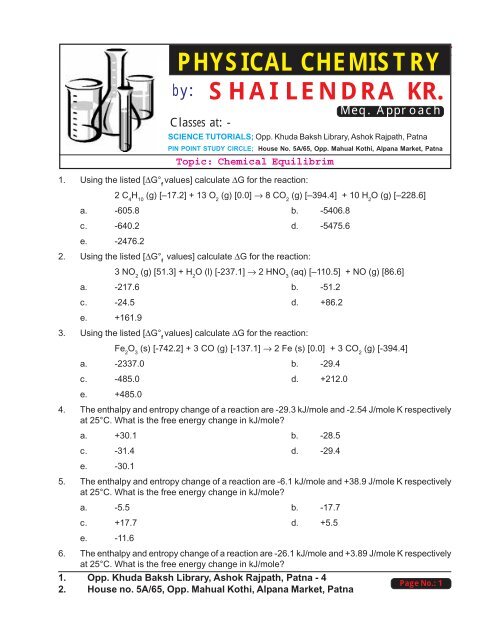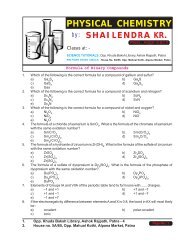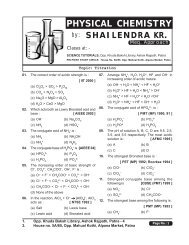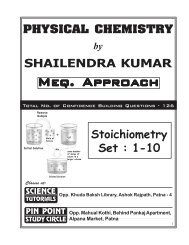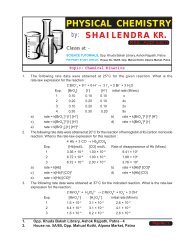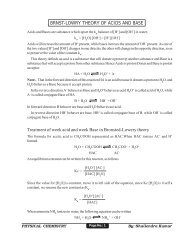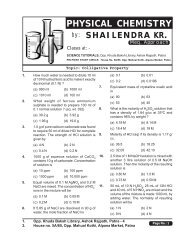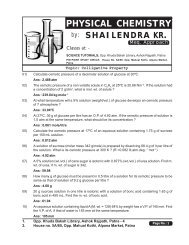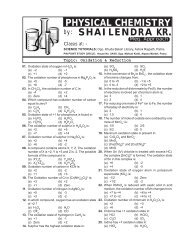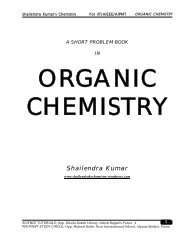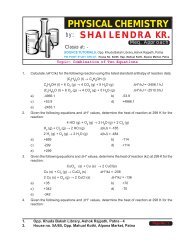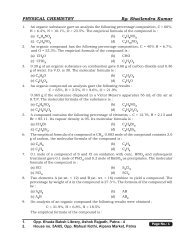Chemical Equilibrium - Shailendra Kumar Chemistry
Chemical Equilibrium - Shailendra Kumar Chemistry
Chemical Equilibrium - Shailendra Kumar Chemistry
Create successful ePaper yourself
Turn your PDF publications into a flip-book with our unique Google optimized e-Paper software.
PHYSICAL CHEMISTRY<br />
By: <strong>Shailendra</strong> <strong>Kumar</strong><br />
PHYSICAL CHEMISTRY<br />
by: SHAILENDRA KR.<br />
Classes at: -<br />
Meq. Approach<br />
SCIENCE TUTORIALS; Opp. Khuda Baksh Library, Ashok Rajpath, Patna<br />
PIN POINT STUDY CIRCLE; House No. 5A/65, Opp. Mahual Kothi, Alpana Market, Patna<br />
Topic: <strong>Chemical</strong> Equilibrim<br />
1. Using the listed [∆G° f<br />
values] calculate ∆G for the reaction:<br />
2 C 4<br />
H 10<br />
(g) [–17.2] + 13 O 2<br />
(g) [0.0] → 8 CO 2<br />
(g) [–394.4] + 10 H 2<br />
O (g) [–228.6]<br />
a. -605.8 b. -5406.8<br />
c. -640.2 d. -5475.6<br />
e. -2476.2<br />
2. Using the listed [∆G° f<br />
values] calculate ∆G for the reaction:<br />
3 NO 2<br />
(g) [51.3] + H 2<br />
O (l) [-237.1] → 2 HNO 3<br />
(aq) [–110.5] + NO (g) [86.6]<br />
a. -217.6 b. -51.2<br />
c. -24.5 d. +86.2<br />
e. +161.9<br />
3. Using the listed [∆G° f<br />
values] calculate ∆G for the reaction:<br />
Fe 2<br />
O 3<br />
(s) [-742.2] + 3 CO (g) [-137.1] → 2 Fe (s) [0.0] + 3 CO 2<br />
(g) [-394.4]<br />
a. -2337.0 b. -29.4<br />
c. -485.0 d. +212.0<br />
e. +485.0<br />
4. The enthalpy and entropy change of a reaction are -29.3 kJ/mole and -2.54 J/mole K respectively<br />
at 25°C. What is the free energy change in kJ/mole?<br />
a. +30.1 b. -28.5<br />
c. -31.4 d. -29.4<br />
e. -30.1<br />
5. The enthalpy and entropy change of a reaction are -6.1 kJ/mole and +38.9 J/mole K respectively<br />
at 25°C. What is the free energy change in kJ/mole?<br />
a. -5.5 b. -17.7<br />
c. +17.7 d. +5.5<br />
e. -11.6<br />
6. The enthalpy and entropy change of a reaction are -26.1 kJ/mole and +3.89 J/mole K respectively<br />
at 25°C. What is the free energy change in kJ/mole?<br />
1. Opp. Khuda Baksh Library, Ashok Rajpath, Patna - 4<br />
Page No.: 1<br />
2. House no. 5A/65, Opp. Mahual Kothi, Alpana Market, Patna
PHYSICAL CHEMISTRY<br />
By: <strong>Shailendra</strong> <strong>Kumar</strong><br />
a. +24.9 b. -27.3<br />
c. -17.3 d. -24.9<br />
e. -30.3<br />
7. From the following ∆H° and ∆S° values predict which of reactions I, II, and III would be spontaneous<br />
at 25°C.<br />
∆H (kJ) ∆S (J/K)<br />
I +10.5 +30<br />
II -10.0 -10<br />
III -5.0 -25<br />
a. II b. I<br />
c. III d. I and II<br />
e. II and III<br />
8. From the following ∆H° and ∆S° values predict which of reactions I, II, and III would be spontaneous<br />
at 25°C.<br />
∆H (kJ) ∆S (J/K)<br />
I +10.5 +30<br />
II +1.8 -113<br />
III -126 +84<br />
a. III b. I<br />
c. II d. I and II<br />
e. II and III<br />
9. From the following ∆H° and ∆S° values predict which of reactions I, II, and III would be spontaneous<br />
at 25°C.<br />
∆H (kJ) ∆S (J/K)<br />
I +10 -10<br />
II -25 +20<br />
III -5.0 -30<br />
a. I and II b. I<br />
c. II d. III<br />
e. II and III<br />
10. Using the listed information calculate ∆G (kJ) for the reaction:<br />
2 Cds (s) + 3 O 2<br />
(g) → 2 CdO (s) + 2 SO 2<br />
(g)<br />
∆H° f<br />
(kJ/mole) -161.9, 0.0, -258.2, -296.9<br />
S° (J/K.mole) 64.9, 205.1, 54.8, 248.2<br />
1. Opp. Khuda Baksh Library, Ashok Rajpath, Patna - 4<br />
2. House no. 5A/65, Opp. Mahual Kothi, Alpana Market, Patna<br />
Page No.: 2
PHYSICAL CHEMISTRY<br />
By: <strong>Shailendra</strong> <strong>Kumar</strong><br />
a. -789.3 b. -832.4<br />
c. -872.8 d. -905.4<br />
e. -744.9<br />
11. Using the listed information calculate ∆G (kJ) for the reaction:<br />
2 Ag (s) + Cl 2<br />
(g) → 2 AgCl (s)<br />
∆H° f<br />
(kJ/mole) 0.0, 0.0, -127.0<br />
S° (J/K.mole) 42.7, 222.9, 96.1<br />
a. -206.4 b. -230.5<br />
c. -252.5 d. -241.6<br />
e. -219.4<br />
12. Using the listed information calculate ∆G (kJ) for the reaction:<br />
C 6<br />
H 12<br />
(g) + 9 O 2<br />
(g) → 6 CO 2<br />
(g) + 6 H 2<br />
O (l)<br />
∆H° f<br />
(kJ/mole) -156.4, 0.0, -393.5, -285.9<br />
S° (J/K.mole) 204.4, 205.1, 213.7, 69.9<br />
a. -3932.2 b. -3888.8<br />
c. -4000.5 d. -4020.3<br />
e. -3816.1<br />
13. Calculate ∆H° f<br />
for TeF 6<br />
from the ∆G of reaction and the S values.<br />
Te (s) + 3 F 2<br />
(g) → TeF 6<br />
(g)<br />
∆G = –1221.5 k<br />
s (J/K.mole) 49.7, 202.9, 337.5<br />
a. -1317.1 b. -1280.4<br />
c. -1415.8 d. -1338.5<br />
e. -1435.7<br />
14. Calculate ∆H° f<br />
for SiF 4<br />
from the ∆G of reaction and the S values.<br />
Si (s) + 2 F 2<br />
(g) → SiF 4<br />
(g)<br />
∆G = -1506 kJ<br />
s (J/K.mole) 18.7, 202.9, 284.5<br />
a. -1614.3 b. -1578.5<br />
c. -1595.3 d. -1675.3<br />
e. -1642.3<br />
15. Calculate ∆H° f<br />
for BrCl from the ∆G of reaction and the S values.<br />
Br 2<br />
(l) + Cl 2<br />
(g) → 2 BrCl (g)<br />
∆G = -2.0 kJ s (J/K.mole) 152.2, 223.1, 240.1<br />
1. Opp. Khuda Baksh Library, Ashok Rajpath, Patna - 4<br />
2. House no. 5A/65, Opp. Mahual Kothi, Alpana Market, Patna<br />
Page No.: 3
PHYSICAL CHEMISTRY<br />
By: <strong>Shailendra</strong> <strong>Kumar</strong><br />
a. +14.6 b. +8.2<br />
c. +29.2 d. +10.2<br />
e. +21.0<br />
16. The entropies of H 2<br />
S (g), H (g) and S (g) are 205.8, and 167.8 J mole –1 K –1 respectively at 298°K.<br />
Using the ∆G° given below calculate the bond energy of H 2<br />
S.<br />
H 2<br />
S (g) → S (g) + 2 H (g)<br />
∆G° = 677.8 kJ<br />
a. 394.1 b. 381.2<br />
c. 367.4 d. 389.3<br />
e. 374.8<br />
17. The molar entropies of NO (g), N (g), and O (g) at 298°K are 210.6, 153.2, and 161.0 J mol –1 K –1<br />
respectively. Using the ∆G° given below calculate the bond energy of NO.<br />
NO (g) → N (g) + O (g)<br />
∆G° = 600.1 kJ<br />
a. 639.0 b. 609.0<br />
c. 631.0 d. 620.0<br />
e. 600.0<br />
18. The entropies of Cl 2<br />
(g) and Cl (g) are 223.0 and 165.1 J mole –1 K –1 respectively at 298°K. Using<br />
the data given calculate the bond energy of Cl 2<br />
.<br />
Cl 2<br />
(g) → 2 Cl (g)<br />
∆G° = +211.4 kJ<br />
a. 241.1 b. 251.4<br />
c. 243.3 d. 246.4<br />
e. 249.5<br />
19. Calculate ∆G° (kJ/mole) at 30°C for a reaction with K eq<br />
= 4.99 x 10 5 .<br />
a. +3.27 b. -3.27<br />
c. -33.1 d. -14.8<br />
e. +33.1<br />
20. Calculate ∆G° (kJ/mole) at 275°C for a reaction with K eq<br />
= 4.33 x 10 –5 .<br />
a. +32.5 b. -23.0<br />
c. +45.8 d. -45.8<br />
e. +23.0<br />
21. Calculate ∆G° (kJ/mole) at 58°C for a reaction with K eq<br />
= 3.11 x 10 2 .<br />
1. Opp. Khuda Baksh Library, Ashok Rajpath, Patna - 4<br />
2. House no. 5A/65, Opp. Mahual Kothi, Alpana Market, Patna<br />
Page No.: 4
PHYSICAL CHEMISTRY<br />
e. 5.9 x 10 5<br />
1. Opp. Khuda Baksh Library, Ashok Rajpath, Patna - 4<br />
2. House no. 5A/65, Opp. Mahual Kothi, Alpana Market, Patna<br />
By: <strong>Shailendra</strong> <strong>Kumar</strong><br />
a. +15.8 b. +2.77<br />
c. -15.8 d. -2.77<br />
e. -8.24<br />
22. The K p<br />
= 0.35 at 25°C for the following reaction. Calculate ∆G° (kJ).<br />
H 2<br />
(g) + I 2<br />
(g) → 2 HI (g)<br />
a. 7.5 b. 4.2<br />
c. 2.6 d. 3.4<br />
e. 5.9<br />
23. The K p<br />
= 9.66 x 10 –16 at 25°C for the following reaction. Calculate ∆G° (kJ).<br />
N 2<br />
(g) + O 2<br />
(g) → 2 NO (g)<br />
a. 92.3 b. 89.2<br />
c. 85.7 d. 81.2<br />
e. 75.0<br />
24. The dissociation of gaseous chlorine to chlorine atoms has K p<br />
= 0.106 atm at 1800°K. Calculate<br />
the free energy change (kJ) for the reaction.<br />
Cl 2<br />
(g) → 2 Cl (g)<br />
a. 7.16 x 10 4 b. 5.22 x 10 4<br />
c. 3.36 x 10 4 d. 5.22 x 10 3<br />
e. 2.12 x 10 3<br />
25. The ∆G°f of H 2<br />
O (l) is -237.2 kJ/mole. Calculate K f<br />
for the following reaction at 25°C.<br />
2 H 2<br />
O (l) → 2 H 2<br />
(g) + O 2<br />
(g)<br />
a. 2.7 x 10 –42 b. 6.8 x 10 –42<br />
c. 2.7 x 10 –84 d. 4.5 x 10 –62<br />
e. 7.6 x 10 –84<br />
26. The ∆G° for the following reaction is -204 kJ. Calculate K p<br />
for the reaction at 25°C.<br />
CO (g) + Cl 2<br />
(g) → COCl 2<br />
(g)<br />
a. 1.8 x 10 –36 b. 6.2 x 10 36<br />
c. 4.2 x 10 32 d. 3.2 x 10 –34<br />
e. 5.5 x 10 35<br />
27. The ∆G° = -32.9 kJ for the following reaction. Calculate K p<br />
at 25°C.<br />
N 2<br />
(g) + 3 H 2<br />
(g) → 2 NH 3<br />
(g)<br />
a. 1.7 x 10 –6 b. 7.2 x 10 5<br />
c. 8.9 x 10 5 d. 3.2 x 10 –6<br />
Page No.: 5
PHYSICAL CHEMISTRY<br />
By: <strong>Shailendra</strong> <strong>Kumar</strong><br />
28. The ∆G° and ∆H° for the following reaction are 48.5 kJ/mole and 100.6 kJ/mole respectively. The<br />
∆S° is 174.8 J/mole K. At what temperature (°C) will the partial pressure of CO 2<br />
equal 1.0 atm?<br />
MgCO 3<br />
(s) → MgO (s) + CO 2<br />
(g)<br />
a. 273 b. 324<br />
c. 303 d. 391<br />
e. 576<br />
29. Using the listed information calculate K p<br />
at 25°C.<br />
2 HgO (s) → 2 Hg (l) + O 2<br />
(g)<br />
∆H° f<br />
(kJ/mole) -90.8, 0.0, 0.0<br />
∆S° (J/K.mole) 70.3, 76.0, 205.1<br />
a. 3.12 x 10 –5 b. 1.43 x 10 –16<br />
c. 2.48 x 10 –5 d. 2.21 x 10 –6<br />
e. 3.12 x 10 –6<br />
30. Using the listed information calculate K p<br />
at 25°C.<br />
Ag 2<br />
O (s) → 2 Ag (s) + 1/2O 2<br />
(g)<br />
∆H° f<br />
(kJ/mole) -31.0, 0.0, 0.0<br />
∆S° (J/K.mole) 121.3, 42.6, 205.1<br />
a. 2.22 x 10 –3 b. 2.22 x 10 –2<br />
c. 1.09 x 10 –2 d. 4.41 x 10 –1<br />
e. 3.41 x 10 –2<br />
31. Consider the ∆G° f<br />
and ∆H° f<br />
(kJ/mole) for the following compounds. Which compound can be<br />
most easily decomposed to from hydrogen gas and an element?<br />
a. CaH 2<br />
(∆G° = -149.8, ∆H° = -188.7)<br />
b. SiH 4<br />
(∆G° = -39.3, ∆H° = -61.9)<br />
c. LiH (∆G° = -69.9, ∆H° = -90.4)<br />
32. Consider the ∆G° f<br />
and ∆H° f<br />
(kJ/mole) for the following oxides. Which oxide can be most easily<br />
decomposed to from the metal and oxygen gas?<br />
a. ZnO : (∆G° = -318.4, ∆H° = -348.3)<br />
b. Ag 2<br />
O : (∆G° = -11.2, ∆H° = -31.1)<br />
c. CdO : (∆G° = -228.4, ∆H° = -258.2)<br />
d. PbO : (∆G° = -187.9, ∆H° = -217.3)<br />
33. Consider the ∆G° f<br />
and ∆H° f<br />
(kJ/mole) for the following oxides. Which oxide can be most easily<br />
decomposed to from the metal and oxygen gas?<br />
1. Opp. Khuda Baksh Library, Ashok Rajpath, Patna - 4<br />
2. House no. 5A/65, Opp. Mahual Kothi, Alpana Market, Patna<br />
Page No.: 6
PHYSICAL CHEMISTRY<br />
By: <strong>Shailendra</strong> <strong>Kumar</strong><br />
a. ZnO : (∆G° = -318.4, ∆H° = -348.3)<br />
b. HgO : (∆G° = -58.5, ∆H° = -90.8)<br />
c. PbO : (∆G° = -187.9, ∆H° = -217.3)<br />
d. Cu 2<br />
O : (∆G° = -146.0, ∆H° = -168.8)<br />
34. The Henry’s Law constant for the dissolution of CO 2<br />
in water are 13.2 and 29.4 atm/M at 0°C and<br />
25°C respectively. Calculate ∆H° (kJ) for the following process.<br />
CO 2<br />
(aq) → CO 2<br />
(g)<br />
a. -21.7 b. -9.42<br />
c. +9.42 d. +49.9<br />
e. +21.7<br />
35. The equilibrium constants for following reaction at 627°C and 897°C are 4.62 x 10 1 and<br />
1.0 x 10 –1 respectively. Calculate ∆H° for the reaction in kJ.<br />
2 SO 2<br />
(g) + O 2<br />
(g) → 2 SO 3<br />
(g)<br />
a. -101 b. -178<br />
c. +101 d. +149<br />
e. +199<br />
36. The equilibrium constants for following reaction at 847°C and 997°C are 6.0 x 10 –4 and<br />
6.88 x 10 –3 respectively. Calculate ∆H° for the reaction in kJ.<br />
Br 2<br />
(g) → 2 Br (g)<br />
a. +114 b. +149<br />
c. -192 d. -114<br />
e. +192<br />
37. The equilibrium constant for the following reaction at 627°C is 46.2. The ∆H° for the reaction is -<br />
197.8 kJ. Calculate the equilibrium constant at 897°C.<br />
2 SO 2<br />
(g) + O 2<br />
(g) → 2 SO 3<br />
(g)<br />
a. 4.1 b. 4.1 x 10 –3<br />
c. 3.2 x 10 –1 d. 2.0 x 10 –2<br />
e. 1.0 x 10 –1<br />
38. The equilibrium constant for the following reaction at 600°C is 3.9 x 10 –1 . The ∆H° for the reaction<br />
is +35.0 kJ. Calculate the equilibrium constant at 900°C.<br />
H 2<br />
(g) + CO 2<br />
(g) → CO (g) + H 2<br />
O (g)<br />
a. 3.3 b. 5.8<br />
c. 2.4 d. 4.2<br />
e. 1.3<br />
1. Opp. Khuda Baksh Library, Ashok Rajpath, Patna - 4<br />
2. House no. 5A/65, Opp. Mahual Kothi, Alpana Market, Patna<br />
Page No.: 7
PHYSICAL CHEMISTRY<br />
By: <strong>Shailendra</strong> <strong>Kumar</strong><br />
39. The equilibrium constant for the following reaction at 1727°C is 4.1 x 10 –4 . The ∆H° for the reaction<br />
is +181 kJ. Calculate the equilibrium constant at 2027°C.<br />
N 2<br />
(g) + O 2<br />
(g) → 2 NO (g)<br />
a. 1.5 x 10 –2 b. 1.1 x 10 –3<br />
c. 6.0 x 10 –2 d. 4.0 x 10 –2<br />
e. 1.7 x 10 –3<br />
40. The equilibrium constant K a<br />
= 3.0 x 10 –8 M at 25°C for the following reaction. Calculate ∆G° (kJ) at<br />
25°C when [ClO – ] = [H + ] = 1.0 x 10 –6 M and [HClO] = 0.10 M.<br />
HClO (aq) → H + (aq) + ClO – (aq)<br />
a. -38.9 b. -62.8<br />
c. -19.9 d. +38.9<br />
e. +42.9<br />
41. The K sp<br />
= 2.0 x 10 7 M –6 for the following reaction at 25°C. Calculate the value of ∆G° (kJ) at 25°C<br />
in a solution when [CO + 3+<br />
3<br />
] = 0.0050 M, [NH 3<br />
] = 0.10 M, and [Co(NH 3<br />
) 6<br />
] = 1.00 M.<br />
+ 3+<br />
Co 3<br />
(aq) + 6 NH 3<br />
(aq) → Co (NH 3<br />
) 6<br />
(aq)<br />
a. -41.7 b. +20.5<br />
c. +5.7 d. -20.5<br />
e. +47.4<br />
42. Calculate ∆G° (kJ) at 25°C for the following reaction when the pressures are as follows:<br />
P = 0.010 atm; P C 2H4 O2 = 0.020 atm; P CO2 = 20 atm; and P H2O = 0.010 atm<br />
C 2<br />
H 4<br />
(g) + 3 O 2<br />
(g) → 2 CO 2<br />
(g) + 2 H 2<br />
O (g)<br />
∆H° (kJ/mole) 52.2, 0.0, -393.5, -241.8<br />
S° (J/K.mole K) 219.6, 205.1, 213.7, 188.8<br />
a. -1252 b. 1346<br />
c. -1282 c. -1314<br />
e. -1387<br />
1. Opp. Khuda Baksh Library, Ashok Rajpath, Patna - 4<br />
2. House no. 5A/65, Opp. Mahual Kothi, Alpana Market, Patna<br />
Page No.: 8
PHYSICAL CHEMISTRY<br />
A N S W E R S<br />
By: <strong>Shailendra</strong> <strong>Kumar</strong><br />
1. b 16. c 31. b<br />
2. b 17. c 32. b<br />
3. b 18. c 33. b<br />
4. b 19. 34. e<br />
5. b 20. 35. e<br />
6. b 21. 36. e<br />
7. a 22. c 37. e<br />
8. a 23. c 38. e<br />
9. a 24. c 39. e<br />
10. e 25. e 40. c<br />
11. e 26. e 41. c<br />
12. e 27. e 42. c<br />
13. 28. c<br />
14. 29. c<br />
15. 30. c<br />
1. Opp. Khuda Baksh Library, Ashok Rajpath, Patna - 4<br />
2. House no. 5A/65, Opp. Mahual Kothi, Alpana Market, Patna<br />
Page No.: 9


